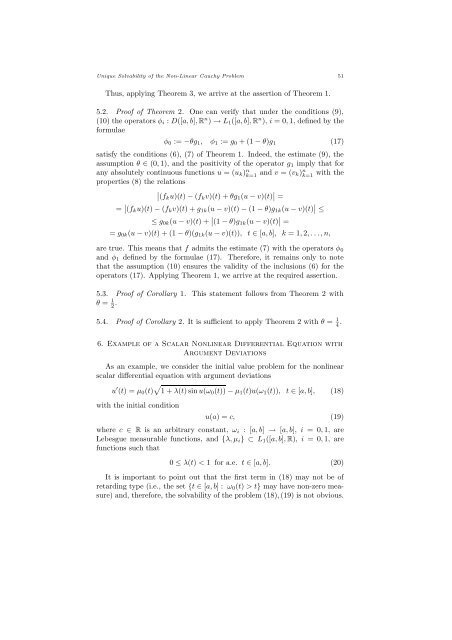ON UNIQUE SOLVABILITY OF THE INITIAL VALUE PROBLEM FOR ...
ON UNIQUE SOLVABILITY OF THE INITIAL VALUE PROBLEM FOR ...
ON UNIQUE SOLVABILITY OF THE INITIAL VALUE PROBLEM FOR ...
Create successful ePaper yourself
Turn your PDF publications into a flip-book with our unique Google optimized e-Paper software.
Unique Solvability of the Non-Linear Cauchy Problem 51<br />
Thus, applying Theorem 3, we arrive at the assertion of Theorem 1.<br />
5.2. Proof of Theorem 2. One can verify that under the conditions (9),<br />
(10) the operators φ i : D([a, b], R n ) → L 1 ([a, b], R n ), i = 0, 1, defined by the<br />
formulae<br />
φ 0 := −θg 1 , φ 1 := g 0 + (1 − θ)g 1 (17)<br />
satisfy the conditions (6), (7) of Theorem 1. Indeed, the estimate (9), the<br />
assumption θ ∈ (0, 1), and the positivity of the operator g 1 imply that for<br />
any absolutely continuous functions u = (u k ) n k=1 and v = (v k) n k=1<br />
with the<br />
properties (8) the relations<br />
∣ (fk u)(t) − (f k v)(t) + θg 1 (u − v)(t) ∣ =<br />
= ∣ ∣ (fk u)(t) − (f k v)(t) + g 1k (u − v)(t) − (1 − θ)g 1k (u − v)(t) ∣ ∣ ≤<br />
≤ g 0k (u − v)(t) + ∣ ∣ (1 − θ)g1k (u − v)(t) ∣ ∣ =<br />
= g 0k (u − v)(t) + (1 − θ)(g 1k (u − v)(t)), t ∈ [a, b], k = 1, 2, . . . , n,<br />
are true. This means that f admits the estimate (7) with the operators φ 0<br />
and φ 1 defined by the formulae (17). Therefore, it remains only to note<br />
that the assumption (10) ensures the validity of the inclusions (6) for the<br />
operators (17). Applying Theorem 1, we arrive at the required assertion.<br />
5.3. Proof of Corollary 1. This statement follows from Theorem 2 with<br />
θ = 1 2 .<br />
5.4. Proof of Corollary 2. It is sufficient to apply Theorem 2 with θ = 1 4 .<br />
6. Example of a Scalar Nonlinear Differential Equation with<br />
Argument Deviations<br />
As an example, we consider the initial value problem for the nonlinear<br />
scalar differential equation with argument deviations<br />
u ′ (t) = µ 0 (t) √ 1 + λ(t) sin u(ω 0 (t)) − µ 1 (t)u(ω 1 (t)), t ∈ [a, b], (18)<br />
with the initial condition<br />
u(a) = c, (19)<br />
where c ∈ R is an arbitrary constant, ω i : [a, b] → [a, b], i = 0, 1, are<br />
Lebesgue measurable functions, and {λ, µ i } ⊂ L 1 ([a, b], R), i = 0, 1, are<br />
functions such that<br />
0 ≤ λ(t) < 1 for a.e. t ∈ [a, b]. (20)<br />
It is important to point out that the first term in (18) may not be of<br />
retarding type (i.e., the set {t ∈ [a, b] : ω 0 (t) > t} may have non-zero measure)<br />
and, therefore, the solvability of the problem (18), (19) is not obvious.

















